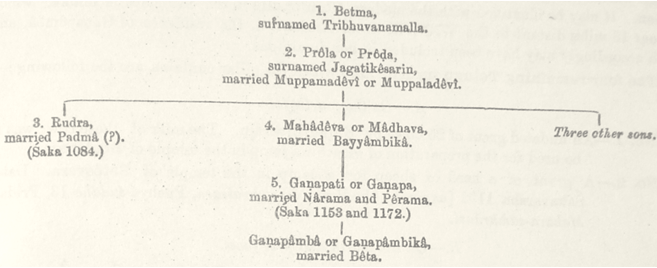|
The Indian Analyst
|
North Indian Inscriptions |
YENAMADALA INSCRIPTION OF GANAPAMBA. ......In the subjoined pedigree of the Kâkatîya dynasty, I have added the new details, supplied by the Gaṇapêśvaram and Yenamadala inscriptions, to the list which I had previously published.1
......After the death of Bêta (v. 16), his widow devoted herself to pious works. She placed golden pinnacles on the shrine of Amarêśvara at Śrî-Dhânyâṅkapura (Amarâvatî) and built “in this city,” i.e. probably at Yenamadala, a temple of Śiva, which she called Bêtêśvara after her deceased husband (vv. 17 to 19), and to which she allotted the revenue of the village of Benadêvî (v. 20). At Śrî-Dhânyâṅkapura (v. 21), she built another temple of Śiva, which she called Gaṇapêśvara after her father, king Gaṇapa (v. 23), and granted to this temple the village of Chintapâḍu (v. 24). Of the three temples which are mentioned in connection with Gaṇapâmbâ, the first, Amarêśvara, still exists at Amarâvatî.2 The second, Bêtêśvara, cannot now be traced at Yenamadala. I do not know if the third, Gaṇapêśvara, still exists at Amarâvatî.
......As regards the Telugu inscriptions on the pillar, the first of them, which occupies
parts of the third and the fourth faces, is a continuation of the Sanskṛit inscription on
the two preceding faces. This follows from the contents of the preserved portion on
the fourth face, and from the abridged English translation of the third face in the Kistna
Manual. At the top of the mutilated third face, some of the titles of the queen are
still preserved. The only remarkable one among these titles, which the queen appears
to have inherited from her deceased husband Bêta and his ancestors, and which are
accordingly in the masculine gender, is: Śrîmat-Triṇayana-Pallava-prasâd-âsâdhita-krishṇa-3
ve[r]ṇṇâ-nadî-dakshiṇa-shaṭsahasr-âvanî-vallabha ; “the lord of a district of six thousand
(villages) on the southern (bank) of the river Kṛishṇaverṇâ, obtained through the
favour of the glorious Triṇayana-Pallava.” The abridged translation supplies the date
Śaka-Saṁvat 1172, the Saumya saṁvatsara, which is now lost in the original, but which there
is no reason to distrust, as the cyclic year Saumya actually corresponds to the Śaka year 1172
(A.D. 1249-50). It follows from this date that Gaṇapâmbâ erected the pillar during the
lifetime of her father Gaṇapati, whose inscription in the Êkâmranâtha temple at Kâñchî
is dated on the 8th June, A. D. 1249, and who appears to have died in Śaka-Saṁvat 1180.4 On
the fourth face we are told, in Telugu, that, “having set up the god Gaṇapêśvara, (the queen)
granted, in order to procure prosperity (abhivṛiddhi) to her father, Gaṇapadêva-Mahârâja, for the requirements (aṅgaraṅgabhôga) of that god, for as long as the moon and the sun shall
endure, the village of Chintapalli.” The inscription of Gaṇapâmbâ ends with a list of the ......1 Ind. Ant. Vol. XXI. p. 197.
| ||||||||||||||||||||||||||||||||||||||||||||||||||||||||||||||||||||||||||||
| > |
|
>
|








